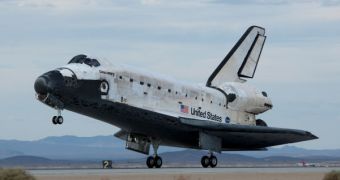It would seem that NASA's latest missions to the ISS and the Hubble Space Telescope were plagued by bad luck, as far as sticking to their landing/take-off schedules was concerned. The STS-128 flight to the International Space Station, carried out with space shuttle Discovery, was no different. After delays in its launch schedule, it also had troubles descending. The shuttle landing strip, located at the Kennedy Space Center (KSC), in Cape Canaveral, Florida, was covered by rain showers on Friday, which prompted mission controllers to redirect the craft to a landing site in California, Space reports.
The spacecraft landed in the Mojave Desert at 8:53 pm EDT (0153 GMT, September 12th), at the Edwards Air Force Base (EAFB). This is the same facility where Atlantis landed after returning from the fifth and final repair mission to the famous Hubble telescope. Discovery's new mission lasted for 14 days, one more than first planned. Early landing windows in Florida could not be used, on account of a storm over the KSC. NASA safety protocols state that, under these conditions, shuttles need to find an alternate landing site.
Last Thursday and Friday were tense days for shuttle astronauts and mission controllers. For two consecutive days, Discovery was waved off from its landing attempts. However, officials state, there was no reason to worry about the safety of the seven astronauts aboard the shuttle. The craft had enough supplies and power to last in orbit until Sunday, but, naturally, nobody wanted to take the risk of waiting this long. As such, the decision to land in California was made.
Discovery spent nine days docked to the ISS, during which time three spacewalks were made. New experiments were added to the outside of the station, and a massive, nearly empty ammonia tank was replaced with a new one, brought up in the shuttle's cargo bay. As the spacecraft separated from the orbital facility, and began its journey back, a Japanese, unmanned cargo ship was successfully launched from the Tanegashima Space Center.
“It is a very important milestone, not just for the International Space Station Program, but also for the Japanese portion of the program because this is a vehicle they have constructed and it is very unique on how it will dock to the space station. It is a precursor to how we may use commercial vehicles to bring supplies to the space station,” Timothy Kopra, the ISS flight engineer that returned home with Discovery, said of the HTV-1. He was replaced by astronaut Nicole Stott.

 14 DAY TRIAL //
14 DAY TRIAL //